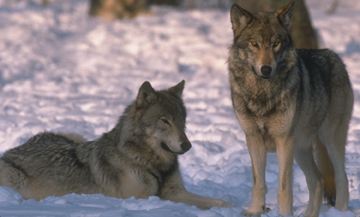By Jim and Jamie Dutcher
Our life-changing experience was about to come to a close. After six years of living with and documenting a pack of wolves in the wilderness, the Forest Service permits allowing our experiment were about to expire. It was time to move the wolves to their next home.
One of the most poignant lessons we ever received from what we had dubbed the “Sawtooth Pack” occurred as we introduced them to their new territory. We carefully sedated each wolf, then loaded them into transport crates, and drove to the Nez Perce Reservation in northern Idaho. At

the end of the journey, the pack faced a transition into an unfamiliar landscape.
The pups seemed unfazed by the trip, so we released them first. Bounding from their crates, they frolicked in the grass. Then we released Kamots, the alpha male of the pack, who immediately went to check on his pups. Finding them well reassured him, and he soon regained his confidence. One by one, the others stepped forward, inspected the pups, and then went to Kamots to offer a supportive lick. The pack was ready to explore their new territory – all except one. Lakota, the timid omega, refused to emerge. He could see his companions were not in danger. Still, he cowered in his crate.
Kamots broke away from the others and returned to his brother, peering in at Lakota. For a while they whined back and forth. At last, the wide-eyed omega poked his nose through the door and sniffed the air. Then he tentatively extended one paw onto the grass. Kamots stepped forward and pressed his shoulder tightly, reassuringly, against his brother’s, and the two walked side by side into the meadow.
It was one of the most touching displays of compassion we had ever witnessed. Kamots would not lead his family into a new territory until his pack was complete. He understood his brother needed encouragement, and he was there to reassure him.
A parallel event occurred one year earlier, when another group of wolves made a similar journey, traveling south from Canada. These were the first wild wolves to be reintroduced into Idaho, and they quickly became the center of controversy and political posturing. Idaho’s governor threatened to use the National Guard to stop their release. There were threats from anti-wolf activists. The reintroduction of wolves to the Northern Rockies had become so contentious that the animals had to arrive under a veil of secrecy.
As handlers unloaded the crates, we could hear stumbling inside, the scrape of nails on metal floors, the body language of fear. As each crate opened, its occupant shot out, bolting toward the cover of the forest – all except one.
The last wolf cowered in her crate and refused to move. A veterinarian stepped forward with a snare pole. He reached the pole into the crate, cinched the loop around the wolf’s throat, and dragged her out. The moment was captured on film and published around the world. The wolf – eyes wild, teeth bared – was the perfect embodiment of our ancient preconceptions, the image of an irredeemably savage beast.
What is the difference between these two frightened wolves—one thrashing and snarling, the other timid and gentle? Human beings are the difference. The panicked wolf was probably an omega like Lakota, and in her desperate moment she lacked the reassurance of a supportive pack. Perhaps if the people surrounding her had moved back and waited, she would have emerged at her own pace.
But that’s not how we deal with wolves. We manage them. We invent rules for them to live by, and kill them for their transgressions. We count them like marbles while politicians decide how many is too many.
Patience and restraint might bring about a more desirable outcome. The more we learn about wolves, the more we see that taking into account their intelligence and their ability to learn and adapt could lead us to a path of coexistence – a path so different from the war against wolves now underway across the United States.
Conflict between our species occurs where wolves’ predatory instincts clash with our hunting and our ranching. So we need an honest and thorough analysis of wolves’ impacts, positive and negative, on livestock, game, tourism, and ecosystems. Once we understand the wolf’s true nature, we’ll be better able to work with it. More than wolves themselves, it is our relationship to wolves that needs to be managed.
As we seek a path toward lasting coexistence, wolves and people need to take the next step together.
From 1990 to 1996 the Dutchers lived with a pack of wolves on the edge of Idaho’s Sawtooth Wilderness. This essay is adapted from their new book, The Hidden Life of Wolves.
This article originally appeared in the Autumn 2013 edition of Earth Island Journal, www.


3 comments on “A Tale of Two Wolves”
Please tell me what, if anything , we can do to stop the USFW Service from annihilating the wolf in the lower 48. Why is our government sanctioning this carnage?
Lisa, you can take action by asking Secretary Jewell to reconsider the proposal to remove Endangered Species Act protections from wolves here: https://action.endangered.org/p/dia/action3/common/public/?action_KEY=14551
Wolves bring balance to many eco-habitats. Take, for instance, Yellowstone National Park. As a result of reintroducing wolves 15 years ago, the deer population (which had eaten much of the grassy meadows) was trimmed, field mice returned as did foxes to feed on them, trees could grow without sapling leaves being eaten by the deer, beavers came, followed by small lakes and marshes where fish, frogs, newts, etc. could breed and thrive, and bears could enjoy the berries from the newly restored meadows and surplus of mammals.
Are we concerned about the cattle that are allowed into biomes that have been desecrated by such farm species? Uh oh….so sad. Please reconsider this decision regarding removing the Endangered Species Act. Thank you…Coco